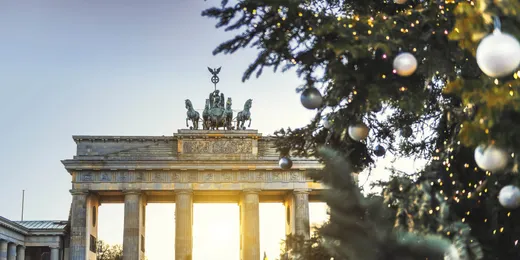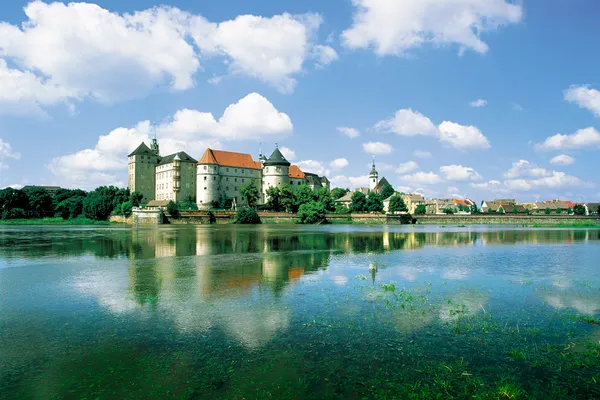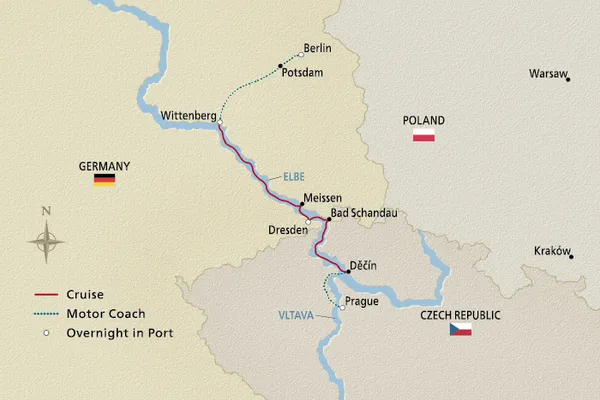
Embark on a captivating journey along the Elbe River
From the rough-hewn rock formations of Saxon Switzerland to the fine porcelain of Meissen, the wonders of the majestic Elbe River await your discovery. Read on to discover a famous German dessert, learn about Johann Sebastian Bach’s connection to the German state of Brandenburg and uncover the history of Wittenberg’s famed Castle Church.

Elbe
The Elbe River runs like an artery through central Europe, flowing from the Czech Republic through Germany to the North Sea. Spanning 724 mi. (1,165 km), the river has served as a vital highway for trade and culture for thousands of years. It carves a path through diverse landscapes, including serene salt marshes, the majestic Elbe Sandstone Mountains and historic cities like Wittenberg and Dresden.
One of the most spectacular stretches of the Elbe is Saxon Switzerland, a national park located 19 mi. (30 km) southeast of Dresden in the German state of Saxony. This spectacular region earned its name from two Swiss painters who were reminded of their home while visiting. As you sail along the Elbe, you can take in striking cliff formations, including the Bastei, a towering collection of jagged rocks connected by a footbridge.
The sandstone mountains of Saxon Switzerland are a direct legacy of ancient sea deposits, eroded over millions of years. As the sea receded, it left behind a thick sandstone bed, which natural forces then carved into the stunning monoliths we see today.
Over the course of centuries, the banks of the Elbe have witnessed many major historical events, including the construction of Meissen’s impressive Albrechtsburg Castle during the 15th century, the birth of the Protestant Reformation in Wittenberg and the incredible reconstruction of Dresden after WWII. Other notable sites that you may visit during a voyage through this remarkable region include:
- Brandenburg Gate
This 18th-century neoclassical monument in Berlin is one of the best-known landmarks in Germany. Between 1961 and 1989, the Berlin Wall closed access to the gate for both East and West Germans. When the gate reopened, it became a powerful symbol of Germany’s reunification. - Sanssouci Palace
Located in Potsdam, Sanssouci was the summer home of Frederick the Great. Designed to his ideal of “living without a care” (sans souci in French), this ornate Rococo palace was built to rival the magnificent French Château de Versailles. - All Saints’ Church
Also known as Castle Church, this UNESCO-listed, late Gothic wonder in Wittenberg is where Martin Luther nailed his famous 95 Theses, sparking the Protestant Reformation. - Zwinger Palace
Built in Dresden during the 18th century, this baroque palace complex has hosted some of the world’s leading composers. It remains a popular venue for visitors to enjoy classical musical performances by members of the Dresden Residence Orchestra. - Prague’s Old Town
The main square of Old Town was a major crossroads on 12th-century trade routes. Today, it is home to a variety of notable architecture and historic sites, including the 15th-century Astronomical Clock, which comes alive every hour with its “Walk of the Apostles.”

-
Cuisine—Dresdner Eierschecke
Walk into any bakery or café in Dresden and you are likely to see a large, eye-catching display of golden rectangles: the classic Dresdner Eierschecke, a delicious sheet cake with three layers. The word eierschecke loosely translates as “egg suit.” The name makes partial sense, considering that each layer of this traditional cake features eggs as a key ingredient. Still, the “suit” may require a little historical context. In 14th-century Germany, a Schecke was a type of men’s frock coat that consisted of three parts: a medium-length tunic; a wide, high waist belt; and the lower part of the suit. The resemblance of the cake’s three layers to this ensemble led to its unusual name.
The base layer of a Dresdner Eierschecke is typically made from a sponge or yeast dough. A thin, custard-like middle layer—the “belt”—is made from butter, egg, sugar, milk, vanilla and a fresh, yogurt-like cheese called quark. The top layer is a creamy, yellow vanilla pudding to which whipped egg whites have been added. In some parts of Germany, you might also find Eierschecke variations with apples, raisins or poppy seeds. All three layers come together to create a taste experience that is sweet but not too sugary.
The German satirist Erich Kästner once described the Dresdner Eierschecke as “a type of cake which, to the detriment of humanity, has remained unknown to the rest of the world.” You may wish to remedy this situation as you travel throughout Saxony and Thuringia, where this three-layered sheet cake is a regional favorite. You may find Eierschecke in food halls, bakeries, coffeehouses and restaurants throughout Dresden all year.
-
Culture—Johann Sebastian Bach
The eastern German state of Brandenburg—namesake of Berlin’s famous Brandenburg Gate—boasts links with many influential German composers, but none more so than classical baroque master Johann Sebastian Bach (1685–1750).
Among the composer’s most famous works are the Brandenburg Concerti—six instrumental pieces which today are considered some of the best-loved orchestral compositions of the era, written out by hand by Bach himself and presented to Christian Ludwig, Margrave of Brandenburg-Schwedt, in 1721. This act all but assured Bach’s place in Brandenburg’s history; however, given the relatively meager scale of the margrave’s court orchestra, it is likely that the concerti most associated with the Brandenburg court were never actually performed there.
Years later, in 1747, Frederick the Great, King of Prussia, invited Bach to Sanssouci Palace, the king’s magnificent summer home in Potsdam. After an evening at the palace spent perusing and playing Frederick’s fine collection of new fortepianos, the great composer improvised a three-part fugue based on a complex 21-note theme given to him by Frederick himself. This fugue managed to incorporate the king’s theme a total of 12 times within a single 17-minute piece, and would go on to become the first movement in Bach’s famous Musical Offering—a series of works sent from Bach, now back home in Saxony, to Frederick the Great a mere two months later.
Bach’s legacy has been recognized in Germany throughout the centuries. In 1901, composer Wilhelm Kempff founded the Bach Society in Potsdam; over 100 years later, in 2007, the Brandenburg Bach Society was established. Since the year 2000, Bach’s life and work have been fully celebrated at the Potsdamer Bachtage, or Potsdam Bach Days. This annual September event features two weeks of concerts, workshops and readings honoring Johann Sebastian Bach and his work. Emphasis is placed on adherence to the composer’s original intention, such as casting only one singer or instrumentalist per composed voice. The event attracts musicians and vocalists from across the region and provides a fitting tribute to Bach’s enduring legacy and global appeal.
-
History—Castle Church
The entrance to Wittenberg’s Castle Church is known across the globe as the door to which Martin Luther nailed his 95 Theses, thus ushering in the Protestant Reformation. Also known as All Saints’ Church, this iconic chapel has undergone numerous iterations throughout its more than 500-year history.
Construction of the church began in 1490 and was completed in 1509. As such, it was still quite new when Luther committed his infamous act on October 31, 1517. This building—including its original wooden doors—was destroyed in 1760 during Europe’s Seven Years’ War. Though quickly rebuilt and consecrated in 1770, the church’s replacement was also badly damaged during Wittenberg’s conflict with Napoleon and his troops in 1813. A new set of bronze doors bearing a Latin inscription of the 95 Theses was unveiled in 1858 in honor of the 375th anniversary of Luther’s birth.
Between 1885 and 1892, with the support of Emperor Wilhelm II, the Castle Church underwent a complete renovation. It was during this time that the church’s soaring 289-foot-high tower was added. Today, it can be seen from nearly everywhere in Wittenberg. Encircling the tower is a tall porcelain frieze displaying the first line of Luther’s most famous hymn, “Ein Feste Burg is Unser Gott” (“A Mighty Fortress is Our God”).
Above the church’s striking doors is a mural painting by August von Kloeber. The work depicts Jesus Christ on the cross along with kneeling images of Martin Luther and Philipp Melanchthon, Luther’s friend and fellow Reformer. Luther holds his 1522 translation of the Bible’s New Testament from ancient Greek and Hebrew into German—the first of its kind, and a feat which made a lasting impact on the modern German language. Melanchthon is depicted holding one of the Reformation’s most important documents, the “Confessio Augustana.” In the background is a view of Wittenberg as seen from the Elbe River’s southern bank, including both St. Marien’s Church (where Luther preached) and the Castle Church itself.
In 1996, Castle Church was designated a UNESCO World Heritage Site. It was renovated yet again between 2013 and 2016, to commemorate the 500-year anniversary of Luther’s historic deed. Though Martin Luther passed away in nearby Eisleben, it is fitting that the famed theologian was entombed in the Castle Church—the site of a seemingly simple act that would go on to change the world.
Elbe Highlights
Embark on a memorable voyage along the picturesque Elbe River and discover the scenic landscapes, culture-rich cities and storied history of Germany and the Czech Republic. Here are some highlights you may experience during your journey:
- Cycle through the historic streets of former East Berlin
- Sample seasonal beer varieties at a German craft brewery
- Experience the ornate Rococo splendor of Sanssouci Palace
- Trace the history of the Protestant Reformation in Wittenberg
- Visit the Bach Museum in charming Leipzig
- Tour the famous Meissen porcelain factory
- See priceless jewels at Dresden’s Green Vault
- Sail through breathtaking Saxon Switzerland
- Explore Bad Schandau, a historic spa resort town
- Discover the incredibly preserved medieval city of Prague
Destination Insight Videos
-
The Berlin Airlift (3:37)
Go behind the scenes at Tempelhof Airport, long closed to visitors, and learn about the famed “Raisin Bombers” and their role during the historic Berlin Airlift, the largest in history.
-
Shopping in Berlin (0:52)
Today’s Berlin is a veritable treasure trove of gift ideas for the holidays. Join Karine as she shares some of her favorite things in the cosmopolitan German capital.
-
Jewish Museum (1:51)
Designed by New York architect Daniel Libeskind, Berlin’s compelling Jewish Museum provides an unforgettable journey through Jewish culture and a rich chronicle of memory and hope.
Elbe Travel FAQ
Enriching Itineraries—Elbe
Choose one of our immersive voyages and discover the many benefits of exploring in Viking comfort.













